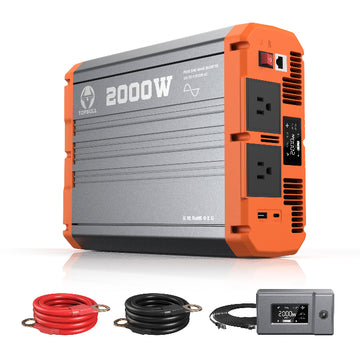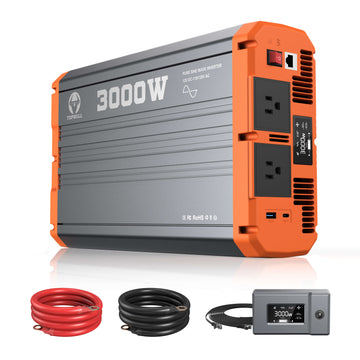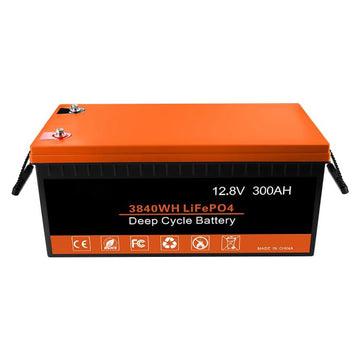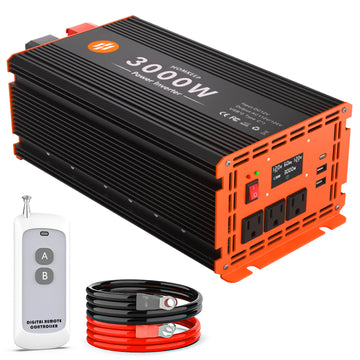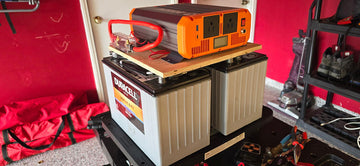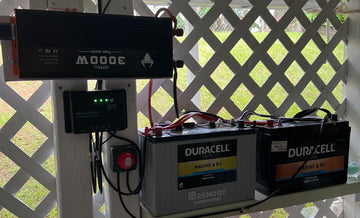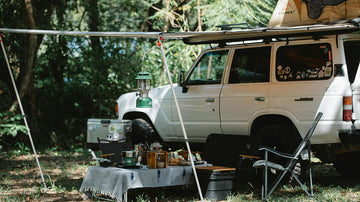In the quest for independence and freedom of off-grid living, a steady supply of energy becomes a crucial factor. And solar generators are growing in demand as green, renewable energy solutions that are not only environmentally friendly, but also provide a steady supply of power to your devices in the event of a power cut. If you want to buy the best solar generator for off-grid living, read this article carefully, which will provide you with a thorough selection guide to help you find the best solar generator for off-grid living.
What is Off-Grid Solar Generator
An off-grid solar generator is a type of solar power system that is not dependent on the external power grid and is able to provide power to equipment independently. The system collects solar energy entirely through solar photovoltaic (PV) panels and converts it into electricity. A solar generator system usually consists of key components such as solar panels, batteries, inverters, and control systems.
- Solar panels: Responsible for converting the sun's energy directly into DC electricity, they are the core component of an off-grid solar generator.
- Battery: Used to store the electricity generated by the solar panel, so as to supply power to the load at night or when there is insufficient light. The capacity and performance of the battery directly affect the continuous power supply ability of the off-grid solar generator.
- Inverter: Converts the DC power in the battery into AC power to meet the demand for AC power in homes, businesses and other loads. The inverter plays a crucial role in the power conversion process.
- Control system: Intelligent management of the entire off-grid solar power generator, including monitoring the power generation of solar panels, charging and discharging status of batteries, and power consumption of loads, etc., to ensure that the system operates stably and efficiently.
Off-grid solar generator has many advantages, such as strong independence, high flexibility, and wide range of application. It is not limited by the coverage of the power grid, and can provide reliable power supply in remote areas, areas without electricity or areas with unstable power grids. At the same time, off-grid solar power generators can also be used as an emergency power source to provide power for critical equipment in emergency situations such as natural disasters.
Types of solar generators for off-grid living
When choosing the right solar generator for off-grid living, you will first need to understand the types of off-grid solar generators, as well as combine them with your actual needs to choose the best off-grid solar generator for you.
Portable solar generators
These generators are usually smaller and lighter in weight, making them easy to carry and move around. They are suitable for outdoor adventure, camping, short trips and other occasions where portable power is needed. The power range is wide, from a few hundred watts to several kilowatts, so you can choose the right model according to your needs. They usually have built-in batteries that can be charged by solar panels or AC power and are suitable for small devices such as mobile phones and laptops.
Whole House Solar Power System
Larger capacity, suitable for daily home electricity and emergency power. Can power multiple high-power devices such as refrigerators and washing machines. Often require a larger array of solar panels for charging. Can be installed in off-grid locations such as caravans or self-built houses.
Suitable for long-term off-grid living and can provide abundant power support.
Solar Backup Generators
These generators are primarily used to provide back-up power for essential appliances and systems during grid outages. An average solar standby generator can cost between $2,000 and $3,000
Demand analysis of solar generators for off-grid living
Commonly used power devices in off-grid living include refrigerators, washing machines, lamps, TVs, computers and so on. These devices have different power requirements, such as refrigerators and washing machines are high-power devices, while lamps and TVs are relatively small. When choosing a solar generator, the power requirements of these devices need to be fully considered to ensure that the generator can meet the normal operation of all the devices.
Power of common electrical equipment used in off-grid life
| Electrical | Running Watts | Starting Watts |
| Window air-conditioner | 1200 | 1800 |
| Electric blanket | 200 | 200 |
| Dehumidifiers | 240 | 240 |
| Space heaters | 600 to 1500 | 600 to 1500 |
| Vacuum | 300 | 500 to 600 |
| Coffee maker | 800 to 1000 | 1000 to 1200 |
| Electric pressure cookers | 1000 | 1000 |
| Toasters | 850 | 900-1000 |
| Dishwasher | 350 | 400-500 |
| Refrigerator | 100 to 800 | 1200 |
| Microwave | 600 to 1200 | 1000-1200 |
| Washing machine | 500 to 1200 | 1500 |
| Hair dryer | 800 to 1800 | 800 to 1800 |
| Televisions | 50 to 400 | 100 |
| Computers | 200 to 600 | 600 |
Special demand considerations:
Instantaneous Power Demand: Some equipment (e.g., air conditioners, water pumps) require high instantaneous power during start-up. Therefore, the solar generator should have a high peak output power to cope with the start-up demand of such equipment.
Automatic operation and remote monitoring: For long-term unattended off-grid systems, the solar generator should have automatic operation and remote monitoring functions so that problems can be detected and dealt with in a timely manner.
Battery capacity and storage: Ensure that sufficient power is available in the event of a lack of sunlight.
Key Factors in Off-Grid Solar Generator Selection
When choosing an off-grid solar generator for outdoor camping and caravanning trips, it is recommended to choose a portable solar generator for short-term trips, while those who are travelling on long-term caravanning trips can choose to equip their entire caravan or campervan with a complete off-grid solar generator system to meet the demand for electricity.
Regardless of whether it is a portable solar generator or a complete off-grid solar generator system, there are specific key factors that need to be taken into consideration when selecting one to ensure the effectiveness and sustainability of the system. Here are some of the important selection factors:
Energy Demand Assessment:
- Calculate your daily electricity consumption, including the power and hours of use of all appliances. The power (e.g., watts) and estimated hours of use for each appliance can be listed to determine the total daily electricity use (kilowatt hours, kWh).
Light conditions:
- Assess the level of solar radiation in your area, including the number of hours of sunlight and light intensity. You can refer to local solar radiation maps or meteorological data in order to estimate solar power potential.
Generating capacity and power rating:
- Select the appropriate solar panel and generator capacity based on your energy requirements and light conditions. Ensure that the power generation capacity can meet the peak and total demand.
Battery selection:
- Select the appropriate battery type (e.g., lead-acid, lithium, gel, etc.) and capacity to store solar energy for use at night or on cloudy days. Ensure that the capacity of the batteries is sufficient to meet the electricity demand for multiple consecutive days without sunlight.
Inverter and Charge Controller:
- Select an efficient inverter to convert DC power to AC power for use in household devices. Charge controllers, on the other hand, are used to manage solar battery charging and discharging, and protect the battery from overcharging or overdischarging.
System efficiency:
- Considers the overall efficiency of the system, including the energy losses of the PV modules, inverter and batteries, to ensure that the actual energy available is as close to the theoretical value as possible.
Equipment durability:
- Select equipment that is weather-resistant and adapted to outdoor environments to ensure that the system can operate stably in bad weather (e.g., high temperature, rain, snow, etc.).
System expandability:
- Consider possible future changes in energy demand and choose a system that is easily expandable to allow for seamless upgrades as electricity usage increases.
Budget and cost-effectiveness:
- Evaluate equipment costs, installation costs, and long-term maintenance costs. Investing in an efficient, durable system can save money in the long run.
Portable solar generators better for camping, RV travelling
For portable solar power generators, start with power output to ensure that the equipment is able to meet the power needs of the appliances required, followed by battery capacity, with preference given to larger capacity lithium batteries for longer usage and faster charging. In addition, the portability and durability of the equipment is also very important, lightweight and with waterproof and dustproof characteristics of the generator is more suitable for outdoor conditions, so as to improve the convenience and safety of use.
Portable solar power systems offer several significant advantages over full solar power systems:
- Portability and Flexibility: Portable solar power systems are usually designed to be lightweight and easy to move around, allowing users to carry and set up as needed. This makes it ideal for outdoor activities such as camping, hiking, and RV travel, whereas complete systems are often fixed and difficult to move.
- Easy Installation: Portable systems typically require no professional installation, as users can simply deploy the solar panels and connect the batteries outdoors. This simplicity means that even beginners can get started quickly, providing a quick power solution, whereas full systems may require professional installation and commissioning.
- Cost-effective: Portable solar power systems are usually relatively inexpensive and suitable for those on a budget. They can provide basic power needs without the need to invest in an expensive complete installation system, thus providing an economical solution for occasional use or temporary needs
2024 Best Off-Grid Solar Generator Recommendations

- Efficient Charging Capability: The 500W power station and 100W solar panel included in the kit can be fully recharged by solar energy in 6-9 hours, ensuring you have a reliable power source in any environment.
- Multiple Output Ports: The power station features multiple output ports, including pure sine wave AC output, USB-A, USB-C PD, DC port and wireless charger, which can meet the charging needs of your different devices.
- Large-capacity power supply: With a large capacity of 519Wh, it can support the operation of a variety of electronic devices and small home appliances without worrying about insufficient power, making it ideal for outdoor activities and family emergencies.
- Wide compatibility: solar panels and power stations are compatible with many brands on the market, equipped with different sizes of connectors, convenient for you to charge a variety of devices, suitable for a variety of use scenarios.
1000W Portable Power Station With 2x 100W Solar Panels, 999Wh Backup Lithium Battery

Solar Generator specificities:
- Portable Solar Generator Kit - Equipped with a high capacity 999Wh battery and two 100W solar panels. Ideal for power outage situations, this kit is powered by the solar panels and is also a great solution for storage and charging while traveling.
- Power ten devices simultaneously - This 1000W solar power station has 2 AC output ports, 1 USB-C PD 60W output, 3 USB-A QC3.0 18W outputs, 1 wireless charging cradle, 1 car port and 2 DC output ports. It can power up to 10 devices simultaneously (as long as the total power does not exceed 1000W). Each switch can independently control the corresponding output module.
- Triple Charging Methods - The 1000W Solar Power Station supports charging from AC outlets, solar panels or vehicle ports. The built-in MPPT (Maximum Power Point Tracking Control) technology extracts maximum power from the solar panels, optimizing the use of unstable power sources such as solar energy.
- Combination Dual Panel - The 100W solar panel supports both series and parallel connections, allowing you to expand your solar panel system as needed. Combined with another solar panel, it can greatly reduce the charging time of the portable power station. The connection process is easy, just use the included MC4 Y-connection cable.
- High Efficiency Conversion Rate - Uses high performance monocrystalline silicon solar cells to convert sunlight into electricity, generating up to 100W and 20V of mobile power. The solar panel captures sunlight up to 23.5% efficiently, and the built-in smart chip intelligently recognizes your device to maximize charging speed while protecting it from damage caused by overcharging and overloading, delivering more power and a longer lifespan than traditional polycrystalline solar panels.
FAQ
What devices can I charge with it?
Off-grid portable solar generators are suitable for charging small electronic devices (e.g. mobile phones, tablets, laptops) as well as small appliances (e.g. small refrigerators, lamps, fans, etc.). It depends on the power of the generator and the output port.
How long does it take to fully charge a portable off-grid solar generator?
Charging time depends on the battery capacity of the solar generator, the power of the solar panels, and the intensity of the sunlight. In general, a full charge may take anywhere from 4 hours to 12 hours.
What is the lifespan of an off-grid portable solar generator?
Generally speaking, the battery life of an off-grid portable solar generator is between 500 and 2,000 charge/discharge cycles, depending on the type of battery and how it is used and maintained.
Can I use and charge at the same time?
Most off-grid portable solar generators support simultaneous charging and powering, but you will need to check the device manual for specific features.
How can I tell if my generator has enough power?
Check the power requirements of the equipment you plan to use (usually marked on the bottom of the unit or on the instruction manual) and choose a solar generator with a slightly higher sum of that power to ensure efficiency and safety.
Can it be used in extreme weather conditions?
Most off-grid solar generators are safe to use within certain temperature ranges, but it is recommended to avoid extreme high or low temperatures, please refer to the product manual for detailed temperature limits.
How do I calculate the area of solar panels I need?
When calculating the area of solar panels needed, it can be estimated based on the power requirements of the generator and the hours of sunlight. The usual standard required is about 1 square metre per 100 watts of solar panel.
Is it possible to plug household appliances directly into the generator?
Yes, but make sure that the power of the household appliances is within the output range of the generator. If the power of the appliance is too high, it may damage the generator or cause a safety hazard.

